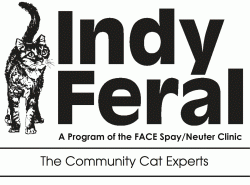|
|
What is TNR? TNR is a process in which stray and feral (wild) cats are humanely trapped, evaluated, vaccinated and sterilized by the veterinarian and then returned to their familiar habitat. We encourage people to make efforts to use the resources of adoption organizations to attempt to place tame cats and kittens into home. Over time, the colony will diminish through natural attrition. TNR is not only cost-effective and humane, but it is scientifically proven as the most effective means of controlling the free-roaming cat population. TNR has been successfully implemented in several cities around the country and is endorsed by many well-respected institutions and organizations as an alternative to trapping and killing stray and feral cats. Groups endorsing TNR include:
Benefits of TNR TNR is effective in reducing the number of cats entering the shelters and is cost-efficient.
Trap and Kill is Ineffective Trapping and killing cats has been proven to be cruel, inefficient and expensive. Whether killing or removing the cats, the cycle continues as it creates a vacuum effect. More cats move in to take advantage of whatever meager food source is available. The new unsterilized cats will breed to capacity of the site and start the cycle all over. An attempt to control the population by removal or killing of cats is often met with opposition and sabotage by cat feeders who have formed an attachment to the cats. Advocates for the cats have been reported to openly violate policies against feeding the cats and interfered with trapping efforts. Cities who have chosen to ignore the problem or "let nature take its course"
have seen nothing but continued breeding, increased suffering, higher mortality
rates, increased nuisance complaints, public health concerns and an eventual
rise in costs to animal control agencies which are eventually passed on to the
taxpayer.
TNR Reduces Nuisance Complaints The majority of complaints received by shelter/animal control facilities are mating behaviors displayed by unsterilized cats. These include yowling, fighting, spraying, unhealthy and sick kittens and roaming. An immediate reduction in these behaviors is realized after the animals are altered. Many cats become friendly and stay closer to home.
Public Health Concerns Are Addressed Through TNR Descriptions of feral cats as generally diseased are not founded in fact. The truth is that feral cats are generally as healthy as domestic cats and present a miniscule health risk to humans. Rabies - cats pose a very low risk for contracting and spreading rabies, as they are not a natural vector for the disease. Feral cats by nature will avoid human contact. All feral cats that are part of managed IndyFeral colonies are vaccinated for rabies and caretakers are instructed to feed cats during the day so as not to attract wildlife and avoid any cat/wildlife confrontation. In Indiana, the last known case of rabies in a cat was 1984, as reported by the Indiana State Board of Animal Health. Impact On Birds And Wildlife The number one cause in the decline of bird and wildlife populations is the
destruction of their habitat, pollution and pesticides. Government biologists
and conservation groups estimate that TV and cell phone towers kill from 4 to
50 million birds a year. Cats are rodent specialists and birds make up a tiny
percentage of their diet. If cats were truly the "hunting-machines"
they are often portrayed as - with the ability to wipe out an entire species
- we would no longer have any mice around.
Quality Of Life And Feral Cats IndyFeral goes one step further than just TNR. We also provide on-going care as part of our comprehensive feral cat management strategy. We insure that every colony has a volunteer (Colony Caretaker) who will provide long-term care, including food, shelter and health monitoring. Caretakers insure that any newcomers who join the colony are immediately spayed/neutered and vaccinated. This on-going surveillance and maintenance is critical for the colony to diminish by natural attrition over time. Caretakers have a strong bond with the free-roaming cats they care for. Caring for a colony of cats is different from the "traditional" image of the human-animal bond, as many of these cats can not be touched or held and do not live indoors with the Caretaker. Nevertheless, it is a close relationship in which Caretakers make great efforts to feed, shelter, neuter and provide health care for the cats. The bond between the caretaker and the cats is no less of a commitment than that of taking care of the family pet and should be recognized as such. Feral cats do not lead "short, miserable lives." On the contrary, as most caretakers and studies can attest, feral cats frequently live long and healthy lives. Quality of life in domestic and stray cats can be measured in terms of weight, coat condition, frequency of illness, eating and drinking patterns and energy level. In a long-term study conducted by the AVMA (American Veterinary Medical Association), no significant differences were noted between domestic and managed feral cats. No More Homeless Pets TNR and managed colonies are not an endorsement for abandoning unwanted cats.
On the contrary, IndyFeral believes that every cat should have a caring and
loving home. TNR should be viewed as an "interim solution" to the
problem of feral, free-roaming cats - it is the first step in reducing the size
of the colony and a critical piece in reaching a day when there are no more
homeless pets.
| |||||||||||||||||||
